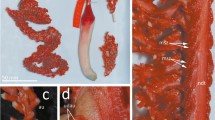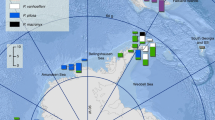Abstract
The crab genus Xantho Leach, 1814 is restricted to the northeastern Atlantic Ocean and the Mediterranean Sea. It consists of four species, Xantho hydrophilus (Herbst, 1790), X. poressa (Olivi, 1792), X. pilipes A. Milne-Edwards, 1867, and X. sexdentatus (Miers, 1881). X. hydrophilus has been divided into two geographic forms, of which one, X. h. granulicarpus (Forest, 1953), is postulated to be endemic to the Mediterranean Sea. In this study, we reconstruct phylogenetic relationships of the genus Xantho and related genera from the Atlantic Ocean or Mediterranean Sea and compare different geographic populations of Xantho hydrophilus and, to a lesser extent, of X. poressa by means of population genetic and morphometric analyses. The molecular phylogeny is based on two mitochondrial genes (large subunit rRNA and cytochrome oxidase I) and indicates that X. poressa, X. hydrophilus and X. sexdentatus form a monophyletic group, the latter two species sharing identical haplotypes. On the other hand, X. pilipes shows affinities to Xanthodius denticulatus. Population genetics based on the COI gene reveal genetic differentiation within X. hydrophilus. Morphometric results also give evidence for distinct geographic forms in X. hydrophilus with a clear discrimination. In comparison, morphometric discrimination between different geographic populations of X. poressa is less clear, but still significant. We therefore suggest a recent/ongoing morphological and genetic differentiation within Xantho hydrophilus, restricted gene flow between its Atlantic and Mediterranean populations (not allowing subspecific differentiation) and possible mtDNA introgression between the species X. hydrophilus and X. sexdentatus.




Similar content being viewed by others
References
Almaça C (1985) Evolutionary and zoogeographical remarks on the Mediterranean Fauna of the brachyuran crabs. In: Moraitou-Apostolopoulou M, Kirotsis V (ed) Mediterranean marine ecosystems, pp 347–366
Avise JC (1994) Molecular markers, natural history and evolution. Chapman & Hall, New York
Avise JC (2004) Molecular markers, natural history and evolution. Sinauer Associates, Inc Publishers, Sunderland (Massachusetts), pp 1–684
Avise JC, Neigel JE, Arnold J (1984) Demographic influences on mitochondrial DNA lineage survivorship in animal populations. J Mol Evol 20:99–105
Borsa P, Blanquer A, Berrebi P (1997) Genetic structure of the flounders Platichtys flesus and P. stellatus at different geographic scales. Mar Biol 129:233–246
Box GEP (1953) Non-normality and tests on variances. Biometrika 40:318–335
Collin R (2001) The effects of mode of development on phyleography and population structure of North Atlantic Crepidula (Gastropoda: Calyptraeidae). Mol Ecol 10:2249–2262
Cuesta JA, Rodríguez A (1994) Early zoeal stages of Pachygrapsus marmoratus (Fabricius), P. transversus (Gibbes), and P. maurus (Lucas) (Decapoda: Brachyura: Grapsidae) reared in the laboratary. Scientia Marina 58(4):323–327
Demeusy N (1958) Recherches sur la mue de puberté du Décapoda Brachyoure Carcinus maenas. Archives de Zoologie Expérimentale et Générale 95:253–492
Drach P, Forest J (1953) Description et répartition des Xantho des mers d‘Europe. Archives de Zoologie Expérimentale et Générale 90(1):1–35
Duran S, Palacín C, Beccerro A, Turon X, Giribet G (2004) Genetic diversity and population structure of the commercially harvested sea urchin Paracentrotus lividus (Echinodermata, Echinoidea). Mol Ecol 13:3317–3328
Excoffier L, Smouse PE, Quattro JM (1992) Analysis of molecular variance inferred from metric distances among DNA haplotypes: application to human mitochondrial DNA restriction data. Genetics 131:491–497
Flowers JM, Foltz DW (2001) Reconciling molecular systematics and traditional taxonomy in a species-rich clade of sea stars (Leptasterias subgenus Hexasterias). Mar Biol 139(3):475–483
Fratini S, Vannini M (2002) Genetic differentiation in the swimming crab Scylla serrata (Decapoda: Portunidae) within the Indian Ocean. J Exp Mar Biol Ecol 272:103–116
Froglia C, Manning RB (1978) Brachynotus gemmellari (Rizza, 1839), the third Mediterranean species of the genus (Crustacea, Decapoda, Brachyura). Proc Biol Soc Wash 91:691–705
García Raso JE, González Gurriarán E, Sardá F (1987) Estudio comparativo de la fauna de crustáceos decápodos braquiuros de tres áreas de la Península Iberica (Galicia, Málaga y Cataluna). Investigación Pesquera 51 Suplemento 1:43–55
Geller JB, Walton ED, Grosholz ED, Ruiz GM (1997) Cryptic invasions of the crab Carcinus detected by molecular phylogeography. Mol Ecol 6:901–906
Guinot D (1967) Recherches préliminaires sur les groupements naturels chez les Crustacés Décapodes Brachyoures. IV. Observations sur quelques genres de Xanthidae. Bulletin du Muséum national D‘Histoire naturelle, Paris 2 39(4):695–727
Hall TA (1999) BioEdit: a user-friendly biological sequence alignment editor and analysis program for Windows 95/98/NT. Nucleic Acids Symp Ser 41:95–98
Holthuis LB (1954) The names of the European species of the genus Xantho Leach, 1814 (Crustacea Decapoda Brachyura). Proceedings, Koninklijke Nederlandse Akademie van Wetenschappen, Amsterdam, series C 57:103–107
Hsü KJ (1983) The Mediterranean was a desert. Princeton University Press, Princeton, New York
Huelsenbeck JP, Ronquist F (2001) MrBayes: Bayesian inference of phylogenetic trees. Bioinformatics 17:754–755
Ingle RW (1983) A comparative study of the larval development of Monodaeus couchi (Couch), Xantho incisus Leach and Pillumnus hirtellus (Linnaeus) (Crustacea: Brachyura: Xanthidae). J Nat Hist 17:951–978
Janson K (1985) A morphologic and genetic analysis of Littorina saxatilis (Prosobranchia) from Venice, and on the problem of saxatilis-rudis nomenclature. Biol J Linn Soc 24:51–59
Ketmaier V (2002) Isolation by distance, gene flow and phylogeography in the Proasellus coxalis-group (Crustacea, Isopoda) in central Italy: allozyme data. Aquat Sci 64:66–75
Kimura M, Weiss GH (1964) The stepping stone model of population structure and the decrease of genetic correlation with distance. Genetics 49:561–576
Kojima S, Kamimura S, Kimura T, Hayashi I, Iijima A, Furota T (2003) Phylogenetic relationships between the tideland snails Batillaria flectosiphonata in the Ryukyu Islands and B. multiformis in the Japaneses Islands. Zool Sci 20:1423–1433
Kyle CJ, Boulding EG (2000) Comparative population genetic structure of marine gastropods (Littorina spp.) with and without pelagic larval dispersal. Mar Biol 137:835–845
Monteiro FA, Solé–Cava AM, Thorpe JP (1997) Extensive genetic divergence between populations of the common intertidal sea anemone Actina equina from Britain, the Mediterranean and the Cape Verde Islands. Mar Biol 129:425–433
Naciri M, Lemaire C, Borsa P, Bonhomme F (1999) Genetic study of the Atlantic/Mediterranean transition in sea bass (Dicentrachrus labrax). Am Genet Assoc 90:591–596
Nei M, Tajima F (1981) DNA polymorphism detectable by restriction endonucleases. Genetics 97:145–163
Palma J, Andrade JP (2002) Morpholgical study of Diplodus sargus, Diplodus puntazzo, and Lithognathus mormyrus (Sparidae) in the Eastern Atlantic and Mediterranean Sea. Fish Res 57(1):1–8
Palumbi SR (1992) Marine speciation on a small planet. Trends Ecol Evol 7(4):114–117
Palumbi SR (1994) Genetic divergence, reproductive isolation, and marine speciation. Ann Rev Ecol Syst 25:547–572
Palumbi SR, Martin A, Romano S, Mcmillan WO, Stice L, Grabowski G (1991) The simple fool‘s guide to PCR. A collection of PCR protocols, version 2. University of Hawai, Honolulu
Pannacciulli FG, Bishop JDD, Hawkins SJ (1997) Genetic structure of populations of two species of Chthamalus (Crustacea: Cirripedia) in the north-east Atlantic and Mediterranean. Mar Biol 128:73–82
Pérez-Losada M, Guerra A, Carvalho GR, Sanjuan A, Shaw PW (2002): Extensive population subdivision of the cuttlefish Sepia officinalis (Mollusca: Cephalapoda) around the Iberian Peninsula indicated by microsatellite DNA variation. Heredity 89(6):417–424
Planes S, Galzin R, Bonhomme F (1996) A genetic metapopulation model for reef fishes in oceanic islands: the case of the surgeonfish, Acanthurus trisotegus. J Evol Biol 9:103–117
Pogson GH, Taggart CT, Mesa KA, Boutilier RG (2001) Isolation by distance in the Atlantic cod, Gadus morhua, at large and small geographic scales. Evolution 55(1):131–146
Posada D, Crandall KA (1998) MODELTEST: testing the model of DNA substitution. Bioinformatics 14:817–818
Quesada H, Beynon CM, Skibinski DOF (1995) A mitochondrial discontinuity in the mussel Mytilus galloprovincialis Lmk: pleistocene vicariance biogeography and secondary intergradation. Mol Biol Evol 12(3):521–524
Rawson PD, Hilbish TJ (1998) Asymmetric introgression of mitochondrial DNA among European populations of blue mussels (Mytilus spp.). Evolution 52(1):100–108
Rodríguez F, Oliver JF, Marín A, Medina JR (1990) The general stochastic model of nucleotide substitution. J Theor Biol 142:485–501
Roman J, Palumbi SR (2004) A global invader at home: population structure of the green crab, Carcinus maenas, in Europe. Mol Ecol 13:2891–2898
Sakai K (1999) J.F.W. Herbst-collection of decapod Crustacea of the Berlin Zoological Museum, with remarks on certain species. Naturalists, Tokushima Biol Lab (6):1–45
Schneider S, Roessli D, Excoffier L (1999) Arlequin ver. 2.0: software for population genetic data analysis. Genetics and Biometry Laboratory, University of Geneva, Geneva, Switzerland
Schneider-Broussard R, Felder DL, Chlan CA, Neigel JE (1998): Tests of phylogeographic models with nuclear and mitochondrial DNA sequence variation in the stone crabs, Menippe adina und Medina mercenaria. Evolution 52(6):1671–1678
Schubart CD, Neigel JE, Felder DL (2000a) Use of the mitochondrial 16S rRNA gene for phylogenetic and population studies of Crustacea. Crustacean Issues 12:817–830
Schubart CD, Neigel JE, Felder DL (2000b) Molecular phylogeny of mud crabs (Brachyura: Panopeidae) from the northwestern Atlantic and the role of morphological stasis and convergence. Mar Biol 137:11–18
Schubart CD, Cuesta JA, Rodríguez A (2001) Molecular phylogeny of the crab genus Brachynotus (Brachyura: Varunidae) based on the 16S rRNA gene. Hydrobiologia 449:41–46
Schubart CD, Cuesta JA, Felder DL (2002) Glyptograpsidae, a new brachyuran family from central America: Larval and adult morphology, and a molecular phylogeny of the Grapsoidea. J Crustacean Biol 22(1):28–44
Slatkin M (1981) Estimating levels of gene flow in natural populations. Genetics 99:323–335
Slatkin M (1985) Gene flow in natural populations. Ann Rev Ecol Syst 16:393–430
Spivak ED, Schubart CD (2003) Species status in question: a morphometric and molecular comparison of Cyrtograpsus affinis and C. altimanus (Decapoda, Brachyura, Varunidae). J Crustacean Biol 23(1):212–222
Swofford DL (1998) PAUP*: Phylogenetic analysis using parsimony and other methods (software). Sinauer Associates, Sunderland, MA
Templeton AR, Crandall KA, Sing CF (1992) A cladistic analysis of phenotypic associations with haplotypes inferred from restriction endonuclease mapping and DNA sequence data. III. Cladogramm estimation. Genetics 132:619–633
Triantafyllidis A, Apostolidis AP, Katsares V, Kelly E, Mercer J, Hughes M, Jorstad KE, Tsolou A, Hynes R, Triantaphyllidis C (2005) Mitochondrial DNA variation in the European lobster (Homarus gammrus) throughout the range. Mar Biol 146:223–235
Udekem d’Acoz C d’ (1999) Inventaire et distribution des Crustacés Décapodes de l’Atlantique nord-oriental, de la Mediterranée et des eaux continentales adjacentes au nord de 25°N. Collection Patrimoines Naturels (Muséum national Histoire naturelle) Paris 40:1–383
Vermeij GJ (1978) Biogeography and adaptation. Patterns of marine life. Harvard University Press, Cambridge, Massachusetts and London, pp 1–332
Wilding CS, Grahame J, Mill PJ (2000) Mitochondrial DNA COI haplotype variation in sibling species of rough periwinkles. Heredity 85:62–74
Williams AB, Felder DL (1986) Analysis of stone crabs: Menippe mercenaria (Say), restricted, and a previously unrecognized species described (Decapoda: Xanthidae). Proc Biol Soc Wash 99(3):517–543
Wright S (1943) Isolation by distance. Genetics 28:114–138
Wright S (1978) Variability within and among natural populations. Evolution and the genetics of populations Chicago, University of Chicago Press.
Zane L, Ostellari L, Maccatrozzo L, Bargelloni L, Cuzin-Roudy J, Buchholz F, Patarnello T (2000) Genetic differentiation in pelagic crustacean (Meganycthphanes norvegica: Euphausiacea) from the North Atlantic and the Mediterranean Sea. Mar Biol 136:191–199
Acknowledgements
Our special thanks go to Senckenberg Museum Frankfurt, Naturalis Museum Leiden, Muséum National d‘Histoire Naturelle Paris, Dirk Brandis, Darryl Felder, Gustavo Flores, Joana Garcia, Danièle Guinot, Jürgen and Maike Heinze, Fernando Mantelatto, Carsten Müller, Tobias Santl, Rafael Robles, Reiner Rubner, José Cuesta, Henrik and Sophia Schubart, Cédric d’Udekem d’Acoz, Peter Wirtz, and Petra Zillner, for helping to collect or sending xanthoid crabs. Thanks are further due to Estelle Roux for helpful discussions of statistical tests, Katja Pusch for support with Arlequin and Anne Hartmann for her comments.
Author information
Authors and Affiliations
Corresponding author
Additional information
Communicated by O. Kinne, Oldendorf/Luhe
Rights and permissions
About this article
Cite this article
Reuschel, S., Schubart, C.D. Phylogeny and geographic differentiation of Atlanto–Mediterranean species of the genus Xantho (Crustacea: Brachyura: Xanthidae) based on genetic and morphometric analyses. Marine Biology 148, 853–866 (2006). https://doi.org/10.1007/s00227-005-0095-1
Received:
Accepted:
Published:
Issue Date:
DOI: https://doi.org/10.1007/s00227-005-0095-1




